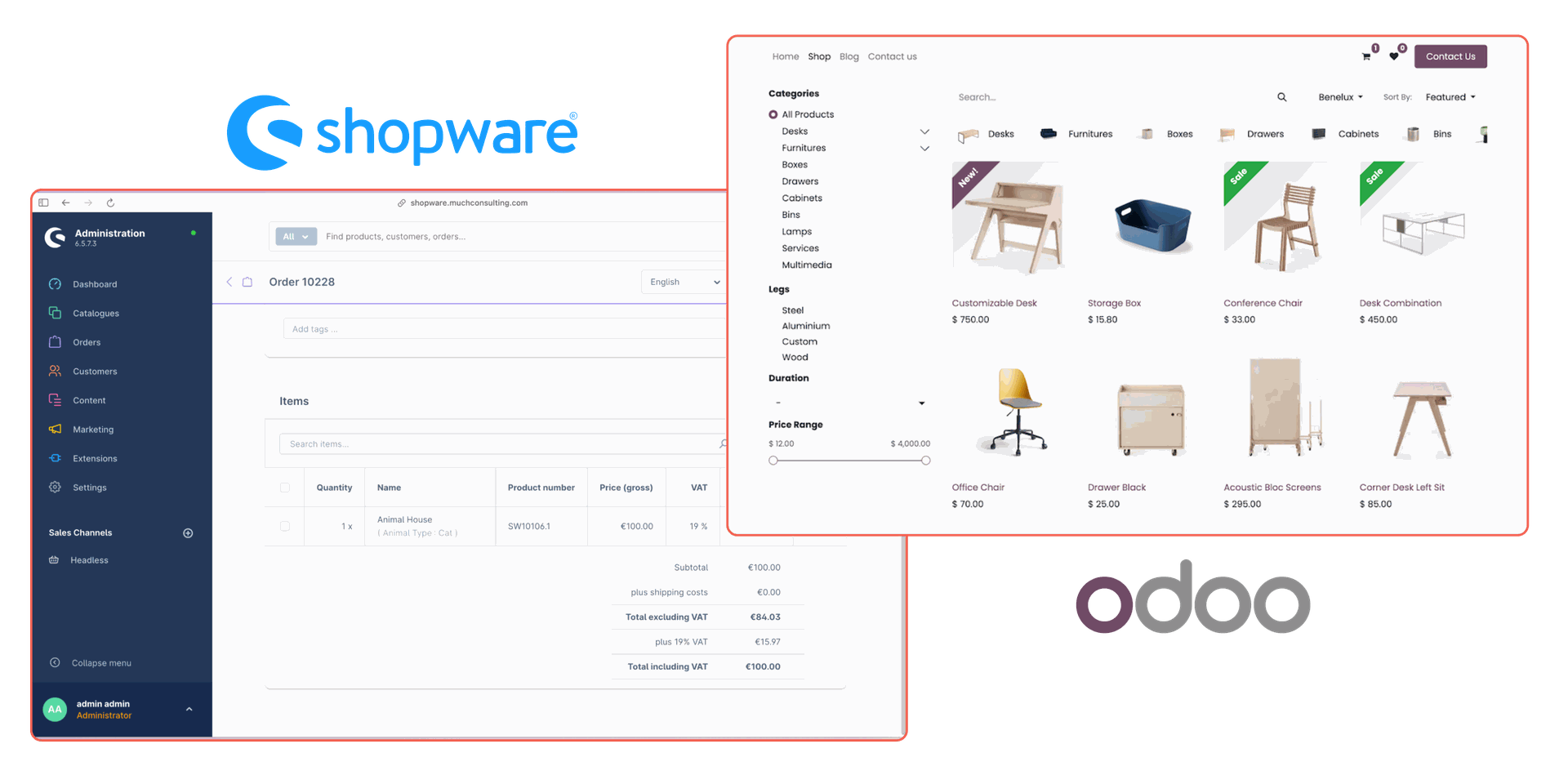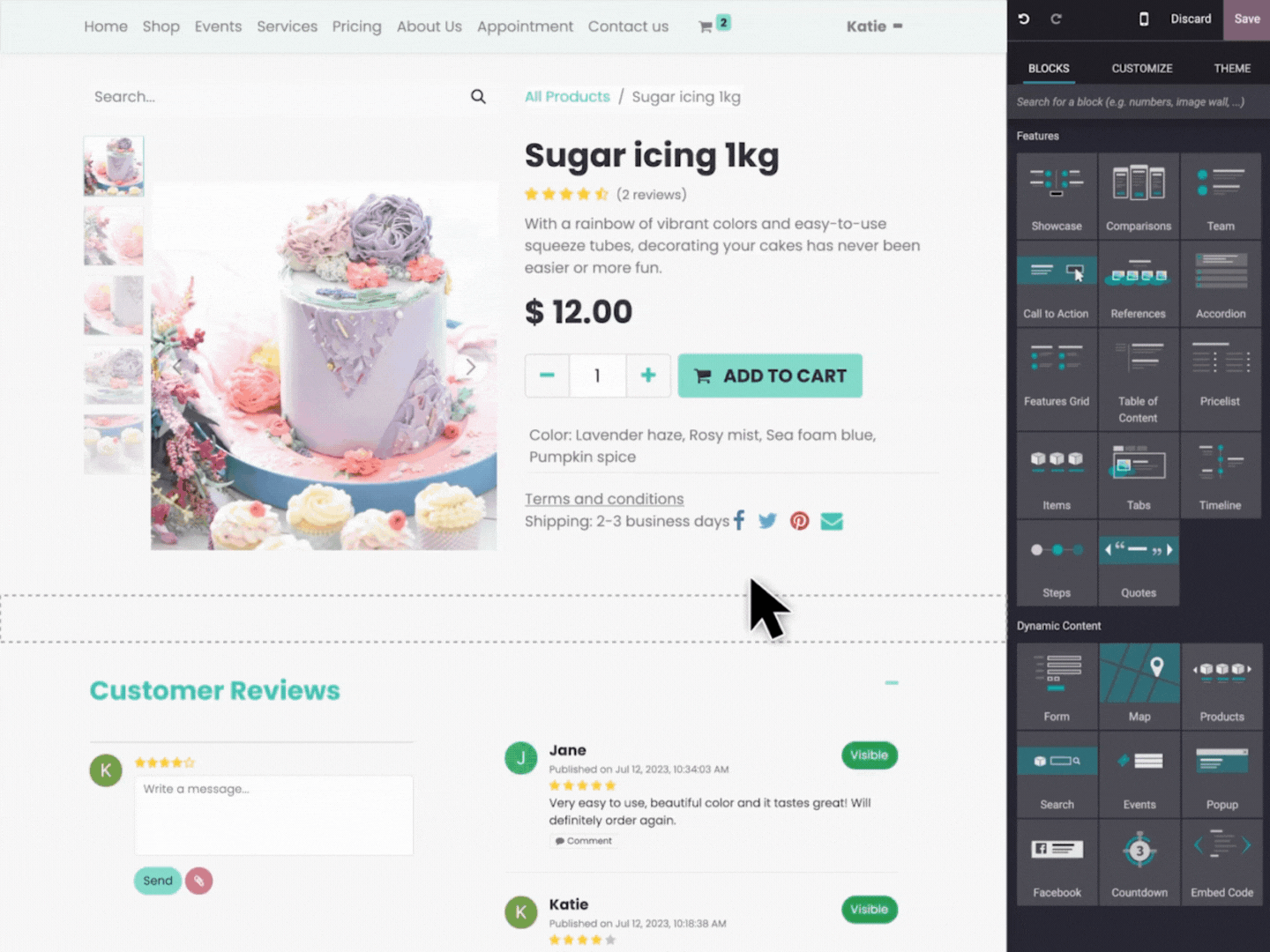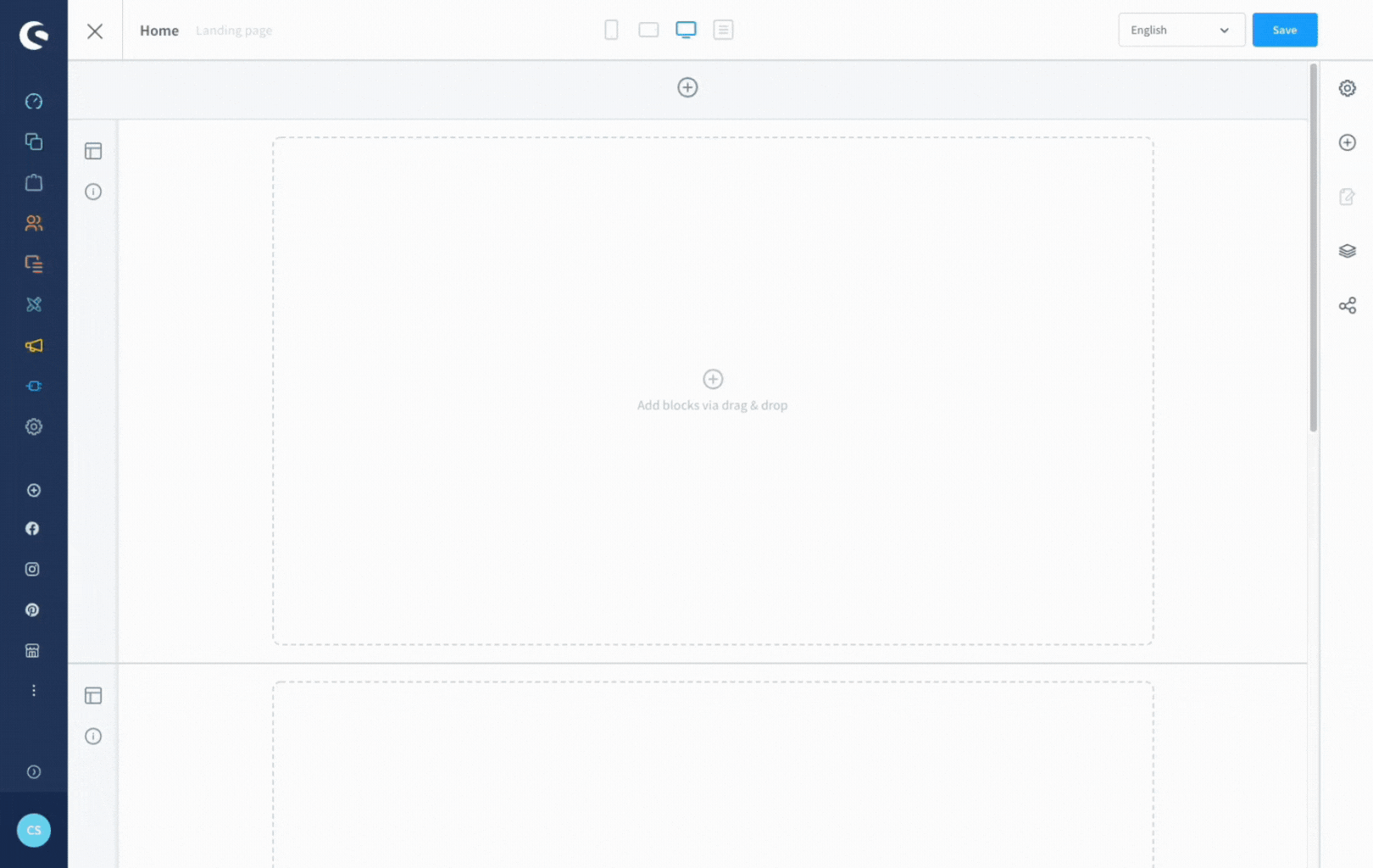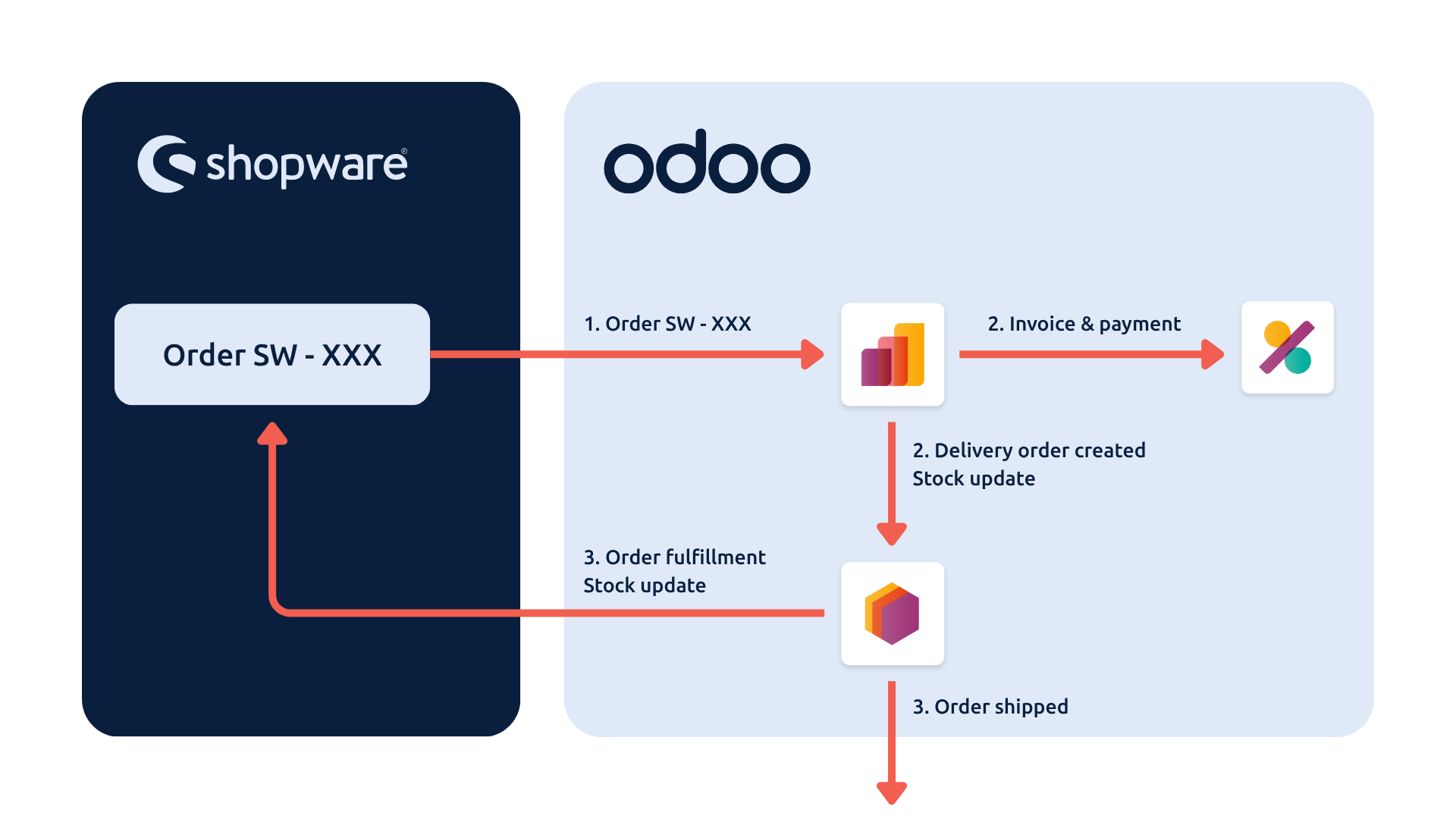Auf einer kürzlich stattgefundenen Odoo Business Show stellte uns ein britischer Geschäftsinhaber die Frage:
"Kann ich meinen gesamten Shop auf Odoo aufbauen?"
Er war ein langjähriger Odoo-Nutzer und wollte auf die hauseigene Webshop-App umsteigen. Er berichtete jedoch von Frustration, da ihm Odoo-Partner immer wieder davon abrieten.
Diese Zurückhaltung ergab sich oft im Vergleich zu etablierten Shop-Systemen in der UK-Region, wie Shopware.
Und es stimmt: Shopware hat sich zu einem der wichtigsten Player für professionelle Frontends entwickelt, während Odoo in diesem Segment noch aufholt.
Wir sagen: Es kommt darauf an.
In diesem Artikel helfen wir Ihnen zu verstehen, wann Odoo E-Commerce sinnvoll ist, wann Sie bei Shopware bleiben sollten und wie eine Integration das Beste aus beiden Welten bieten kann.

Odoo eCommerce integriert sich in ein vollständiges Business-System
Odoo E-Commerce ist nahtlos in das gesamte Odoo-System eingebunden.
Es ist ein Webshop, aber es ist gleichzeitig Teil einer größeren Suite, die von Inventar und Einkauf bis hin zu Buchhaltung und Helpdesk alles abdeckt.
Das macht die App attraktiv für Unternehmen, die ihr Geschäft bereits auf Odoo betreiben oder ein zentralisiertes System ohne externe Abhängigkeiten wünschen.

Kurzübersicht
- Aktuelle Version: Odoo 18
- Hosting Optionen: Odoo.sh (Cloud), On-Premises
- Lizenz: Kommerziell (Open-Source-Basis)
- Preis: Ab 29,90 € pro Nutzer/Monat (ca. 26 £)
Ideal, wenn...
Sie Odoo bereits als ERP nutzen oder planen zu nutzen.
Sie ein vollständig integriertes Backend ohne externe Konnektoren benötigen.
Sie B2B-, Hybrid- oder Make-to-Order-Produkte verkaufen.
Sie B2C Produkte in geringen Volumen verkaufen (z. B. hochpreisige Artikel).
Sie die operative Kontrolle über Vertrieb, Lager und Support priorisieren.
Nicht ideal, wenn...
Ihr Shop auf modernstes Frontend-Design oder Nischen-Themes angewiesen ist.
Sie Odoo in keinem anderen Geschäftsbereich einsetzen.
Sie eine hohe B2C-Traffic-Kapazität benötigen.
Sie auf Plugins für Marketing, Werbeaktionen oder die Benutzererfahrung beim Bezahlvorgang angewiesen sind.
Shopware ist für Frontend-Performance und Wachstum konzipiert
Shopware ist eine leistungsstarke E-Commerce-Plattform, die für skalierbaren Vertrieb konzipiert wurde.
Sie bietet einen robusten Funktionsumfang für Händler, die sich auf Wachstum, Storytelling und Kundenerlebnis konzentrieren.
Shopware unterstützt sowohl B2C als auch B2B durch seine Enterprise-Funktionen, doch seine Kernstärke liegt in der flexiblen Frontend-Logik, dem API-Zugang und einem reichhaltigen Ökosystem an Plugins und Integrationen.

Kurzübersicht
- Aktuelle Version: Shopware 6
- Hosting Optionen: Cloud, selbst gehostet oder Headless
- Lizenz: Kommerzielle und Open-Source-Editionen
- Preis: Ab 600 € pro Monat (ca. 524 £) im Rise-Plan, kostenlose Community Edition verfügbar
Ideal, wenn...
Sie schnelle Launch-Zeiten mit starken Frontend-Tools wünschen.
Sie Design, UX und Konversions-Funktionen priorisieren.
Sie einen B2C-Shop mit hohem Volumen betreiben und Drittanbieter-Tools nutzen.
Nicht ideal, wenn...
Sie tief vernetzte Backend-Operationen ohne Middleware benötigen.
Sie ein Unternehmen mit komplexer Fertigungs- oder Lagerlogik führen.
Sie Systeme konsolidieren möchten, anstatt mehrere Stacks zu verwalten.
Sie die Wartung von Plugins oder Abhängigkeiten von mehreren Anbietern vermeiden möchten.
Odoo eCommerce vs. Shopware im Überblick
OOdoo und Shopware repräsentieren zwei unterschiedliche Ansätze für den E-Commerce:
Funktion / Fähigkeit | Odoo eCommerce | Shopware |
Plattformmodell | Teil einer All-in-one Business Suite (ERP) | Eigenständige E-Commerce-Plattform |
Backend-Integration | Native Integration mit ERP, CRM, Inventar | Externe Integration erforderlich |
Frontend-Flexibilität | Einfacher Page Builder | Headless-fähig, visueller CMS, Themes |
Transaktionskapazität | Moderat (Backend-zentriert) | Skaliert auf hohe Volumen im Frontend |
B2B/B2C-Fähigkeiten | Eingebautes B2B, Hybrid-fähig | B2C nativ, B2B über Plugins |
Customising | Open-Source, vollständig anpassbar | Modular über Plugins und API |
Preisgestaltung | Nutzerbasiert (ab 29,90 € pro Nutzer/Monat) | Umsatzbasiert (ab 600 € pro Monat im Rise-Plan) |
Idealer Anwendungsfall | Unternehmen, die bereits Odoo ERP nutzen | Wachstumsstarke Shops mit Frontend-Anforderungen In Google Sheets exportieren |
Das Fazit: Wann Odoo und wann Shopware?
Wenn Ihre Prioritäten auf einem benutzerdefinierten Backend, komplexer Produktlogik, Make-to-Order-Workflows und langfristiger Systemkontrolle liegen, kann Odoo E-Commerce die richtige Wahl sein.
Das gilt insbesondere, wenn Sie Odoo bereits nutzen und zusätzliche Integrationsarbeit vermeiden möchten.
Wenn Sie jedoch Frontend-Flexibilität, High-Volume-Performance und auf Marketing ausgerichtete Funktionen benötigen, ist Shopware immer noch die stärkere Option.
Das zeigte sich auch beim Geschäftsinhaber auf der Business Show: B2B-Workflows, mehrstufige Konfiguratoren und strenge Kontrollanforderungen machten Odoo zur natürlichen Wahl für seine Backend-Operationen.
Er wollte keine Abhängigkeit von einem weiteren externen Anbieter schaffen, was den Fall für Odoo im Backend stärkte. Aber für die Schaufensterfunktion (Storefront) war Shopware besser geeignet.
In solchen Fällen ist die beste Lösung nicht, sich zwischen Odoo E-Commerce oder Shopware zu entscheiden, sondern beide zu kombinieren.
Der goldene Mittelweg: Odoo-Shopware-Integration
Wenn Sie bereits Shopware nutzen oder dessen Frontend-Stärke wünschen, aber dennoch die volle Backend-Kontrolle durch Odoo behalten möchten, gibt es eine gute Nachricht: Sie können beides verbinden.
Eine Odoo-Shopware-Integration erlaubt Ihnen:
- Shopware für den kundenorientierten Shop zu nutzen.
- Produkte, Lagerbestände, Bestellungen und Fulfillment in Odoo zu verwalten..
- Daten in Echtzeit zu synchronisieren, um doppelte Logik zu vermeiden.
So funktioniert es:
- Produktkataloge und Lagerbestände werden von Odoo an Shopware übermittelt (pushed).
- In Shopware aufgegebene Bestellungen werden automatisch in Odoo abgerufen (pulled).
- Kundendaten, Rechnungen und Lieferstatus werden in Odoo abgewickelt.
- Sie pflegen das Shopware-Frontend und das Design, ohne operative Effizienz zu verlieren.
- Odoo wird zur Single Source of Truth: von Produkten über Steuern bis hin zu Preisen und Lagerbeständen.
Dieses Setup ist ideal, wenn:
- Sie B2C skalieren und die Frontend-Stärken von Shopware benötigen.
- Sie aus Datensilos oder Tabellenkalkulationen herausgewachsen sind.
- Sie Logistik, Fulfillment und Buchhaltung unter Odoo vereinheitlichen möchten.
Es bietet das Beste aus beiden Welten, insbesondere für Unternehmen, die ihre Shopware-Präsenz nicht aufgeben wollen, aber das Backend-Chaos mit Odoo beseitigen möchten.

Odoo und Shopware nähern sich an
Odoo verbessert seine E-Commerce-Funktionen mit jeder Version, was sich in optimierten Website-Tools, schnellerer Seiten-Performance und besserer Designkontrolle zeigt.
Gleichzeitig erweitert Shopware seine Backend-Logik mit Flow Builder, Rule Builder und leistungsfähigeren B2B-Funktionen. Die Grenzen zwischen Storefront und Business-System beginnen zu verschwimmen.
Dennoch wird keines der Systeme alles alleine leisten, zumindest noch nicht.
Der Trend, den wir am häufigsten beobachten: Unternehmen beginnen mit der Integration und entscheiden später, welche Teile konsolidiert werden, sobald Klarheit über die optimalen Prozesse herrscht.
Ob dies bedeutet, schrittweise zu einem vollständigen Odoo-Setup zu wechseln, langfristig bei Shopware zu bleiben oder ein stabiles Hybrid-Setup zu betreiben die Architektur ist entscheidend.
Nicht sicher, welche Wahl für Sie richtig ist?
Wir sind ein Odoo Gold Partner mit Erfahrung in der Integration von Shopware und anderen Plattformen in maßgeschneiderte Business-Setups.
Wenn Sie unsicher sind, ob Sie vollständig auf Odoo umsteigen, Shopware integrieren, oder Ihr aktuelles Setup optimieren sollen, helfen wir Ihnen gerne weiter.